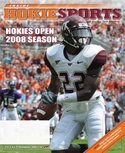There aren’t many feelings like walking into a stadium and getting that first view of the beautiful green field on which your favorite team plays. But don’t take it for granted – there are a lot of people hard at work year-round to keep it looking like it does. One of those people is Jason Bowers, Virginia Tech’s sports turf and athletic grounds manager who oversees Lane Stadium/Worsham Field. Pioneer Athletics, the nation’s leading developer and manufacturer of field marking paint, recognized Bowers and his staff last year as the winner of the Field of Excellence award and placed Worsham Field on the cover of the company’s annual calendar. Bowers recently shared some of the ins and outs of his job as the brass of the grass.
It’s tougher than maintaining your yard at home.
“A lot of people think, ‘My lawn at home is green. Why doesn’t Tech’s field look good?’ But with the heights we mow the grass and the stress that it takes everyday from the athletes, it’s just ridiculous. Most yards probably get mowed at three or four inches, but our football practice field is an inch and a half, while the baseball, softball and soccer fields are an inch and a quarter. Worsham Field is at a half of an inch. When you have 300-pound guys trampling all over it, it takes a beating.”
The grass has a mind of its own.
“All of our athletic fields except Worsham Field are Bluegrass, which is a cool-season grass. They get treated a little differently than Bermuda grass, which is what you see at the football games. Bermuda thrives better in the heat, but we’ve had such a cool summer this year and that’s why it has a light brown singe to it right now. With some of the 45- and 50-degree nights we’ve had, the grass got fooled. It was thinking ‘Oh no, winter’s coming. I’ve got to start going dormant.’ That’s when it turns brown – it takes all of its chlorophyll and stores it in its roots to save for the spring. That’s made it a challenge this year, but it’s a challenge every year. If it would’ve been really hot, the Bermuda would be loving life right now, but all the other fields would be screaming.”
It’s a fine line choosing which type of grass to use.
“Bluegrass is prettier in the fall, so when soccer is going strong in September, October and November, that’s when it will look its best. You just get a better color out of it. It’s also probably the most tolerant to foot traffic and the stress that gets put on it. But football likes Bermuda because you can keep it shorter, and coaches everywhere believe (whether it’s true or not) that the taller the grass, the slower your players will be. Soccer also wants Bermuda because lower grass height means a faster ball roll, but it’s very expensive to change out.”
There’s a science to what they do.
“Sometimes we will seed over the Bermuda with Ryegrass, which is good for color, but it’s not as heat tolerant and it is very susceptible to disease. We do that for TV games, because without the color, everyone would think the grass is dead. Then we have to spray out the Ryegrass after the season because it competes with the Bermuda for nutrients and light.”
Taking care of the field is not their only duty.
“We’re also responsible for all of the landscaping around all of the athletic facilities, which is a year-round job in itself, especially with all of the improvements and renovations our facilities have undergone. We’re also weathermen of sorts, and we’re equipped with the weather service information on our computers. During baseball and softball season, even on off days, we’ve got to constantly monitor the forecast so the tarp can get pulled in time. During football games, we’ve got to keep the referees informed if there’s any lightning in the area.”
They’re the offensive linemen of the athletics department.
“You’ve got to like what you do in our job because we are the low man on the totem pole. But if Coach Beamer is happy with it, that’s all that matters. With all of the things that he deals with, it’s tough for him to even know everyone’s name. But when he passes me in the hallway and says, ‘Hey Jason, that field looked great,’ it’s a good feeling to know that he knows who you are and what you do. It’s nice to get that pat on the back and approval from the coaches.”
They’re artists, and the field is their canvas.
“Throughout the season, I like the challenge of getting the fields to look better, but what I enjoy most is that first game of the season – getting the field painted and having it look sweet for everybody to see. Last year for East Carolina, it just looked awesome – it was perfect. Having that feeling of accomplishment is great – I’ve even had referees commenting on how good it’s looked. We work our tails off, but it’s all worth it for that final visual.”




